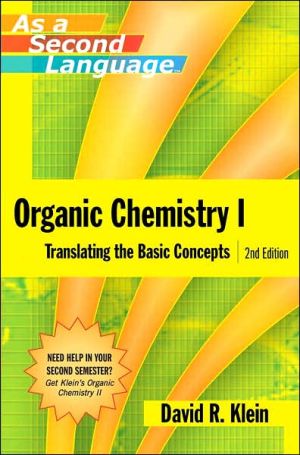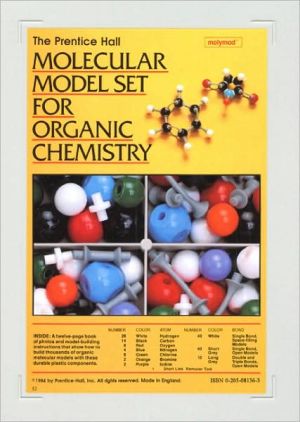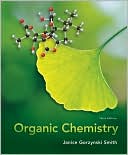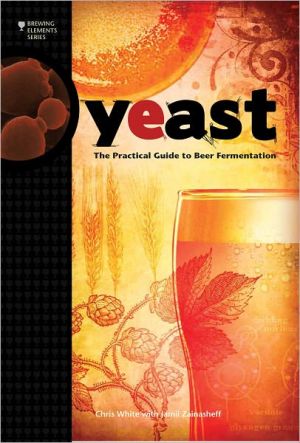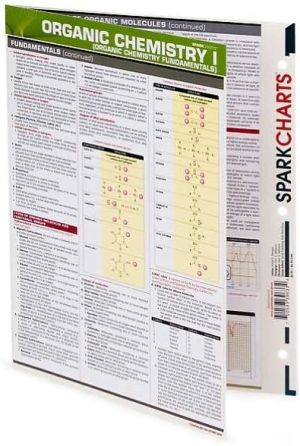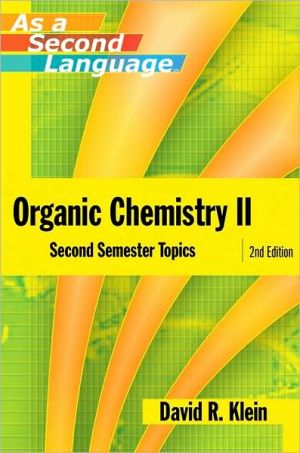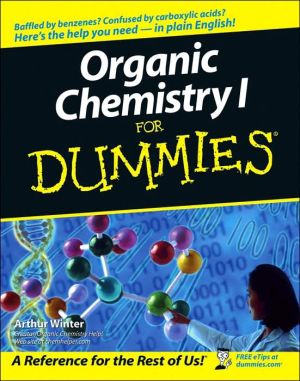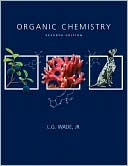Fundamentals of Organic Chemistry
Retaining the concise, to-the-point presentation that has already helped thousands of students move beyond memorization to a true understanding of the beauty and logic of organic chemistry, this Seventh Edition of John McMurry's FUNDAMENTALS OF ORGANIC CHEMISTRY brings in new, focused content that shows students how organic chemistry applies to their everyday lives. In addition, redrawn chemical structures and artwork help students visualize important chemical concepts, a greater emphasis on...
Search in google:
Written for the short course-where content must be thorough, but to-the-point, FUNDAMENTALS OF ORGANIC CHEMISTRY, Sixth Edition, continues to provide an effective, clear, and readable introduction to the beauty and logic of organic chemistry. McMurry presents only those subjects needed for a brief course while maintaining the important pedagogical tools commonly found in larger books. With clear explanations, thought-provoking examples, and an innovative vertical format for explaining reaction mechanisms, FUNDAMENTALS takes a modern approach: primary organization is by functional group, beginning with the simple (alkanes) and progressing to the more complex. Within the primary organization, there is also an emphasis on explaining the fundamental mechanistic similarities of reactions. Through this approach, memorization is minimized and understanding is maximized. The sixth edition brings in new content that applies organic chemistry to students, for example all of the chapter openers have been changed and incorporate a model and photograph of an application of organic chemistry such as Taxol from the pacific yew tree. The book introduces a running application in the Interlude boxes and in the problems relating agricultural chemicals intended to unify the subject further for students. All of the problems have been reorganized by topic to make easier to assign and review. New problem categories have been added. The new problem categories are In the Field with Agrochemicals" and "In the Medicine Cabinet" to reinforce the focus on applications." Booknews A standard text for a brief course in organic chemistry. The primary organization is by functional group, beginning with alkanes and going on to more complex compounds. This revised edition features expanded problem sets, many new drill problems, and a new chapter titled "The Organic Chemistry of Metabolic Pathways." Annotation c. Book News, Inc., Portland, OR (booknews.com)
PrefacexviA Note for Studentsxxi1Structure and Bonding; Acids and Bases11.1Atomic Structure31.2Electron Configuration of Atoms51.3Development of Chemical Bonding Theory61.4The Nature of Chemical Bonds71.5Forming Covalent Bonds: Valence Bond Theory101.6Hybridization: sp[superscript 3] Orbitals and the Structure of Methane111.7Hybridization: sp[superscript 3] Orbitals and the Structure of Ethane121.8Hybridization: sp[subscript 2] Orbitals and the Structure of Ethylene131.9Hybridization: sp Orbitals and the Structure of Acetylene161.10Polar Covalent Bonds: Electronegativity171.11Acids and Bases: The Bronsted--Lowry Definition201.12Acids and Bases: The Lewis Definition242The Nature of Organic Compounds: Alkanes342.1Functional Groups352.2Alkanes and Alkyl Groups: Isomers412.3Naming Branched-Chain Alkanes462.4Properties of Alkanes492.5Conformations of Ethane502.6Drawing Chemical Structures532.7Cycloalkanes542.8Cis--Trans Isomerism in Cycloalkanes552.9Conformations of Some Cycloalkanes572.10Axial and Equatorial Bonds in Cyclohexane602.11Conformational Mobility of Cyclohexane613The Nature of Organic Reactions: Alkenes743.1Naming Alkenes753.2Electronic Structure of Alkenes783.3Cis--Trans Isomers of Alkenes793.4Sequence Rules: The E,Z Designation813.5Kinds of Organic Reactions843.6How Reactions Occur: Mechanisms863.7The Mechanism of an Organic Reaction: Addition of HCl to Ethylene893.8Describing a Reaction: Reaction Energy Diagrams and Transition States923.9Describing a Reaction: Intermediates944Reactions of Alkenes and Alkynes1054.1Addition of HX to Alkenes: Hydrohalogenation1064.2Orientation of Alkene Addition Reactions: Markovnikov's Rule1064.3Carbocation Structure and Stability1094.4Addition of H[subscript 2]O to Alkenes: Hydration1114.5Addition of X[subscript 2] to Alkenes: Halogenation1134.6Addition of H[subscript 2] to Alkenes: Hydrogenation1154.7Oxidation of Alkenes: Hydroxylation and Cleavage1164.8Biological Addition Reactions of Alkenes1184.9Addition of Radicals to Alkenes: Polymers1194.10Conjugated Dienes1224.11Stability of Allylic Carbocations: Resonance1244.12Drawing and Interpreting Resonance Forms1264.13Alkynes and Their Reactions1285Aromatic Compounds1435.1Structure of Benzene: The Kekule Proposal1445.2Structure of Benzene: The Resonance Proposal1455.3Naming Aromatic Compounds1465.4Electrophilic Aromatic Substitution Reactions: Bromination1495.5Other Electrophilic Aromatic Substitution Reactions1535.6The Friedel--Crafts Alkylation and Acylation Reactions1545.7Substituent Effects in Electrophilic Aromatic Substitution1565.8An Explanation of Substituent Effects1585.9Oxidation and Reduction of Aromatic Compounds1625.10Polycyclic Aromatic Hydrocarbons1635.11Organic Synthesis1646Stereochemistry1776.1Stereochemistry and the Tetrahedral Carbon1786.2The Reason for Handedness in Molecules: Chirality1806.3Optical Activity1836.4Specific Rotation1846.5Pasteur's Discovery of Enantiomers1866.6Sequence Rules for Specifying Configuration1876.7Diastereomers1916.8Meso Compounds1936.9Molecules with More Than Two Stereocenters1956.10Racemic Mixtures and the Resolution of Enantiomers1966.11Physical Properties of Stereoisomers1996.12A Brief Review of Isomerism1996.13Chirality in Nature2017Alkyl Halides2117.1Naming Alkyl Halides2127.2Preparing Alkyl Halides2137.3Reactions of Alkyl Halides: Grignard Reagents2157.4Nucleophilic Substitution Reactions2177.5The S[subscript N]2 Reaction2207.6The S[subscript N]1 Reaction2247.7Eliminations: The E2 Reaction2287.8Eliminations: The E1 Reaction2307.9A Summary of Reactivity: S[subscript N]1, S[subscript N]2, E1, E22327.10Substitution Reactions in Living Organisms2338Alcohols, Phenols, and Ethers2438.1Naming Alcohols, Phenols, and Ethers2448.2Properties of Alcohols, Phenols, and Ethers: Hydrogen Bonding2468.3Properties of Alcohols and Phenols: Acidity2488.4Synthesis of Alcohols2508.5Reactions of Alcohols2538.6Synthesis and Reactions of Phenols2588.7Synthesis and Reactions of Ethers2618.8Cyclic Ethers: Epoxides2628.9Thiols and Sulfides2649Aldehydes and Ketones: Nucleophilic Addition Reactions2769.1The Nature of Carbonyl Compounds2779.2Naming Aldehydes and Ketones2799.3Synthesis of Aldehydes and Ketones2819.4Oxidation of Aldehydes2829.5Nucleophilic Addition Reactions of Aldehydes and Ketones: Reduction2839.6Nucleophilic Addition of Water: Hydration2859.7Nucleophilic Addition of Alcohols: Acetal Formation2889.8Nucleophilic Addition of Amines: Imine Formation2909.9Nucleophilic Addition of Grignard Reagents: Alcohol Formation2919.10Conjugate Nucleophilic Addition Reactions2949.11Some Biological Nucleophilic Addition Reactions29510Carboxylic Acids and Derivatives30510.1Naming Carboxylic Acids and Derivatives30610.2Occurrence and Properties of Carboxylic Acids31010.3Synthesis of Carboxylic Acids31310.4Nucleophilic Acyl Substitution Reactions31410.5Reactions of Carboxylic Acids31710.6Chemistry of Acid Halides32010.7Chemistry of Acid Anhydrides32210.8Chemistry of Esters32410.9Chemistry of Amides32910.10Chemistry of Nitriles33110.11Polymers from Carbonyl Compounds: Nylons and Polyesters33411Carbonyl Alpha-Substitution Reactions and Condensation Reactions34711.1Keto--Enol Tautomerism34811.2Reactivity of Enols: The Mechanism of Alpha-Substitution Reactions35211.3Alpha Halogenation of Aldehydes and Ketones35311.4Acidity of Alpha Hydrogen Atoms: Enolate Ion Formation35511.5Reactivity of Enolate Ions35811.6Alkylation of Enolate Ions35911.7Carbonyl Condensation Reactions36211.8Condensations of Aldehydes and Ketones: The Aldol Reaction36211.9Dehydration of Aldol Products: Synthesis of Enones36411.10Condensations of Esters: The Claisen Condensation Reaction36611.11Biological Carbonyl Reactions36812Amines37912.1Naming Amines38012.2Structure and Properties of Amines38312.3Basicity of Amines38312.4Synthesis of Amines38612.5Reactions of Amines39212.6Heterocyclic Amines39312.7Alkaloids: Naturally Occurring Amines39713Structure Determination40613.1Infrared Spectroscopy and the Electromagnetic Spectrum40713.2Infrared Spectroscopy of Organic Molecules41013.3Ultraviolet Spectroscopy41513.4Interpreting Ultraviolet Spectra: The Effect of Conjugation41613.5Nuclear Magnetic Resonance Spectroscopy41813.6The Nature of NMR Absorptions41913.7Chemical Shifts42213.8Chemical Shifts in [superscript 1]H NMR Spectra42313.9Integration of [superscript 1]H NMR Spectra: Proton Counting42513.10Spin--Spin Splitting in [superscript 1]H NMR Spectra42613.11Uses of [superscript 1]H NMR Spectra43013.12[superscript 13]C NMR Spectroscopy43014Biomolecules: Carbohydrates44114.1Classification of Carbohydrates44214.2Configurations of Monosaccharides: Fischer Projections44414.3D,L Sugars44614.4Configurations of Aldoses44814.5Cyclic Structures of Monosaccharides: Hemiacetal Formation45014.6Monosaccharide Anomers: Mutarotation45214.7Reactions of Monosaccharides45414.9Polysaccharides46014.10Other Important Carbohydrates46314.11Cell-Surface Carbohydrates and Carbohydrate Vaccines46315Biomolecules: Amino Acids, Peptides, and Proteins47215.1Structures of Amino Acids47315.2Isoelectric Points47815.3Peptides and Proteins48115.4Covalent Bonding in Peptides48215.5Peptide Structure Determination: Amino Acid Analysis48415.6Peptide Sequencing: The Edman Degradation48415.7Peptide Synthesis48715.8Classification of Proteins49015.9Protein Structure49115.10Enzymes49415.11How Do Enzymes Work? Citrate Synthase49716Biomolecules: Lipids and Nucleic Acids50716.1Lipids50816.2Fats and Oils50816.3Soaps51116.4Phospholipids51316.5Steroids51516.6Nucleic Acids and Nucleotides51716.7Structure of DNA52016.8Base Pairing in DNA: The Watson--Crick Model52116.9Nucleic Acids and Heredity52416.10Replication of DNA52416.11Structure and Synthesis of RNA: Transcription52616.12RNA and Protein Biosynthesis: Translation52716.13Sequencing DNA53016.14The Polymerase Chain Reaction53217The Organic Chemistry of Metabolic Pathways54017.1An Overview of Metabolism and Biochemical Energy54117.2Catabolism of Fats: [beta]-Oxidation Pathway54417.3Catabolism of Carbohydrates: Glycolysis54917.4The Citric Acid Cycle55417.5Catabolism of Proteins: Transamination55717.6The Organic Chemistry of Metabolic Pathways: A Summary559AppendixesANomenclature of Polyfunctional Organic Compounds1BGlossary8CAnswers to Selected In-Chapter Problems18Index1
\ From the Publisher"We have found the McMurry texts to be unique in their utility for our two cycle approach and we are able to efficiently service two groups of students with different needs. For these reasons, we have been satisfied and have seen no reason for change." Robert Cameron, Samford University\ "Chapter 9 is well organized and includes an appropriate selection of material given the overall topic. The in-chapter problems are well chosen and presented in a timely manner. The illustrations are helpful and there are lots of end-of-chapter problems for students to work." Steven Holmgren, Montana State University\ "Chapter 17 is an excellent chapter…. It seems as though the author has a particular fondness for this topic that shows in his thoughtful and entertaining handling of the subject matter. The use of color to help students follow the transfer of atoms and pieces of molecules during catalytic reactions in this chapter is very effective. The author is also commended for his frequent reminders to the reader that these biological processes are comprised of organic reactions that they have studied earlier in the book." Alvan C. Hengge, Utah State University\ \ \ \ \ \ BooknewsA standard text for a brief course in organic chemistry. The primary organization is by functional group, beginning with alkanes and going on to more complex compounds. This revised edition features expanded problem sets, many new drill problems, and a new chapter titled "The Organic Chemistry of Metabolic Pathways." Annotation c. Book News, Inc., Portland, OR (booknews.com)\ \ \ From The CriticsMcMurry (Cornell U.) presents the new edition of his textbook, which is organized according to functional group, beginning with the simple alkenes and progressing to the more complex biomolecules. With emphasis on the fundamental mechanistic similarities of reactions, coverage includes acids and bases, alkenes and alkynes, aromatic compounds, stereochemistry, alkyl halides, alcohols, phenols, ethers, aldehydes and ketones, carboxylic acids and derivatives, carbonyl alpha-substitution reactions and condensation reactions, amines, structure determination, and the organic chemistry of metabolic pathways. Annotation c. Book News, Inc., Portland, OR\ \

